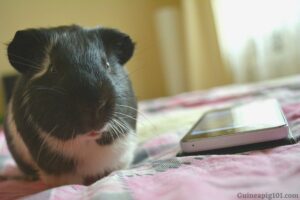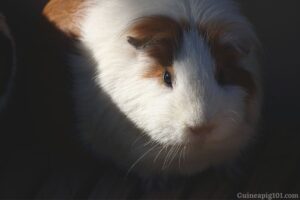Table of Contents
Measuring the width of tunnels and hideouts
Guinea pigs passing through tunnels, holes, or any other narrow passageway use their whiskers to determine the width of the passageway.
Because the length of the whiskers is equal to the length of the body, the sensory nerve determines whether the width is greater than the width of the whiskers or not. Obese guinea pigs have difficulties because their whiskers are designed for a standard body width.
Because of their whiskers, they will not enter any narrow passageway, which may be perplexing to some people.
Feeling nearby objects
Guinea pigs are unable to focus on a nearby object in order to measure its depth and distance in the same way that humans can.
Despite having a wide field of vision, they rely on their whiskers for tasks that require them to be close to the face.
It is fascinating to learn that nerve endings can be found throughout the entire body’s covering. Because of this, they are extremely responsive to touch.
If you approach your guinea pig from behind, they may become frightened or behave erratically because they are constantly on the lookout for predators who might attack them.
Navigating
Guinea pigs are able to move around even when they are unable to see clearly due to inadequate lighting conditions. In the dark, they navigate with the help of their whiskers.
Guinea pigs can find their way out of a situation even when there is nothing visible around them. They have the ability to detect the presence of any danger in their immediate vicinity.
Eye Protection
Whiskers are also used to protect the eyes, which is a significant advantage. Protecting the eyes is made easier by the whiskers that surround the brows.
They deflect any particles that are on their way to the eyes, thereby protecting them. They also issue a warning when there is a danger or an object near the head that could cause damage to the eyes.
Guinea pigs rely on the feedback mechanism of the touch to survive and reproduce. They are not only capable of navigating through the house, but they are also adept at using their whiskers for protection.
Check out this article on whether guinea pigs can close their eyes.
How do whiskers work in guinea pigs?
Mammals have a different type of hair on their bodies called vibrissae, which is distinguished by its long length and the presence of nerves in the hair follicle.
Hairs like these are distinct from the normal hairs that can be found on the skin of mammals. The touch sensory region of the brain is associated with the presence of these hairs. The stimulus received by the brain from these hairs is interpreted by the brain.
The protein keratin is responsible for the formation of the hair’s body or shaft. This same protein can be found in the shaft of healthy hair, indicating that they are related.
In the shaft of the hair, there are no nerve cells to be found. As a result, guinea pigs do not experience any discomfort when their whiskers are cut.
The whisker follicle is distinct from other hair follicles in that it contains a blood capsule, which makes it unique among other hairs. This blood capsule is equipped with sensory nerves.
If you look closely, you will notice that the arrangement of the whiskers is clearly defined. The number of whiskers on each side of the face is the same and countable on both sides of the face.
Whiskers can be found on a wide variety of animals, both terrestrial and aquatic in their habitat. The length varies depending on where you are in the world. When compared to the whiskers on the back of the head, the whiskers on the front are shorter.
Should I cut my guinea pigs whiskers
Absolutely not! You should never attempt to cut or trim the whiskers of your guinea pigs!
Over a hundred afferent nerve cells supply the whiskers with nutrients and oxygen. The message is carried to the brain by these nerves.
As a result of the stimuli that are received, the receptors in the brain generate electrical impulses. Any deflection, no matter how slight, can be felt by these receptors. Mechanoreceptors are receptors that are sensitive to mechanical forces and movements.
Whiskers serve as an important organ in the body as a result. They are not simply unprocessed natural hair that we can cut and style as desired. Guinea pigs will have difficulty moving around if their whiskers are missing.
How many whiskers do guinea pigs have?
Whiskers can be found on both sides of the face of a Guinea pig. On the brow, above the eyes, a few whiskers can be found. Others are on the cheek, the mouth, and the nose at the same time as you.
In spite of this, guinea pigs have significantly fewer whiskers than other rodents.
Numerous motion sensors embedded within the vibrissae hair follicles detect and record the movements of the body.
Every follicle is equipped with hundreds of motion detectors. Every time a cat’s whiskers brush against an object, the motion sensors embedded in the follicles detect and record the brushing.
Upon receiving information about the location and shape of the object, the nerves make a decision about how to proceed next.
What happens if you cut a guinea pig whiskers?
It is not recommended that whiskers be clipped because they are an important sensory tool to have. Guinea pigs have a limited ability to concentrate on objects that are in close proximity to their eyes.
As a result, if we remove the whiskers from your guinea pig, he or she will have limited navigational abilities.
When it comes to trimming the guinea pig’s fur, caution should be exercised. Fortunately, even if you trim your whiskers too short, they will regrow quickly. If your guinea pig has lost its ability to see, you should exercise extreme caution when handling its whiskers.
My guinea pigs whisker are too long
Make a close examination of the whiskers on your pet’s guinea pig to see if they are curled at the ends or excessively long.
If they appear to be frayed, you can trim them a little to bring them back into form.
Long enough whiskers are required, and they should not be trimmed until they have reached a satisfactory condition.
Given that their whiskers do not contain any nerve endings, you will not experience any discomfort when you trim their whiskers.
If you find yourself in the following situation, you should avoid cutting your whiskers :
It is entirely different from trimming whiskers to trim the fur on one’s face.
Guinea pigs require long whiskers despite the fact that they appear to be too long.
However, just because you are not encountering any resistance from your guinea pig while cutting does not mean that you are free to cut the whiskers short.
Depending on how much you trim the whiskers from your Guinea pig, it may exhibit behavioral changes. Whiskers play an important role in navigation.
Even so, if it becomes necessary to trim the whiskers, there isn’t much to be concerned with. On their own, whiskers can regenerate.
Do guinea pig whiskers grow back?
Whiskers can regrow in the same way that the fur on the rest of the body can. Whiskers go through a cycle of growth and shedding that is predetermined.
No cause for alarm should be raised because guinea pig whiskers have fallen from the animal’s face.
If you notice that your guinea pig’s whiskers are falling out and not being replaced over time, it is possible that he is suffering from a medical condition. To help your guinea pig, you will need to seek professional assistance.
Also read: All about shedding in guinea pigs
Guinea pig whiskers falling off
Guinea pigs do not lose their whiskers completely in normal circumstances, and it is also very rare.
Causes of whisker falling out
One or more of the following factors may be responsible for the loss of whiskers:
- Guinea pigs fighting amongst themselves: Guinea pigs are capable of fighting amongst themselves, and when they do, they attack the face, genitals, and lower portion of the body. It is possible that whiskers will break as a result of this.
- Alopecia: Guinea pigs suffering from severe stress begin to lose their whiskers as a result of attacks on the follicles of their immune system. Alopecia is a condition that can affect any animal, including humans, and is caused by a genetic mutation.
- Microbiological infections: Any type of bacterial infection on the face of the guinea-pigs can result in the loss of whiskers.
- Fungal infections: A ringworm-like infection on the face of a guinea pig indicates the presence of a fungal infection. That can result in the loss of whiskers and the formation of round patches.
- Dermatitis and other skin-specific conditions: An allergic disease such as eczema or hives can cause whiskers to fall out.
- Mite infestations result in the loss of whiskers and furs, as well as the formation of sores and irritation.
- Hormonal disorders: Any disruption in the hormonal balance, such as hypothyroidism, can result in hair loss as well as the loss of whiskers.
Having your guinea pig’s whiskers fall out is not a good thing for him. As a result, if you notice your cat losing whiskers and they are not being replaced with new ones, take him to the veterinarian right away.




